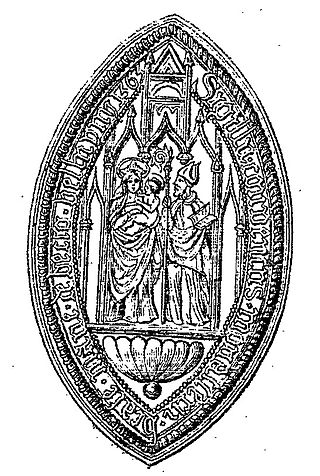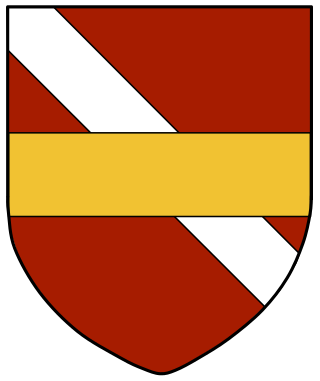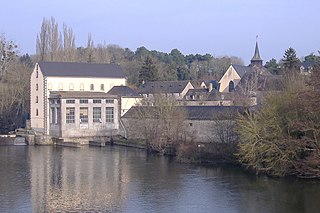
Cormeilles Abbey (French : Abbaye Notre-Dame de Cormeilles) was a Benedictine monastery in Cormeilles, Normandy, in what is now the commune of Saint-Pierre-de-Cormeilles, Eure, France. The buildings are now almost completely destroyed.

Cormeilles Abbey (French : Abbaye Notre-Dame de Cormeilles) was a Benedictine monastery in Cormeilles, Normandy, in what is now the commune of Saint-Pierre-de-Cormeilles, Eure, France. The buildings are now almost completely destroyed.
William FitzOsbern and Adeliza de Tosny founded the abbey [1] in around the year 1060, and endowed it richly with lands in England, after the Norman Conquest. He was buried there in 1071. [2] According to Ordericus Vitalis it was one of two religious foundations he established on his estates. [3] The other was the Abbaye Notre-Dame de Lyre.
The abbey had fallen into disrepair by the fifteenth century. After a series of partial reconstructions, it was suppressed in 1779. [4]
The buildings are now almost completely destroyed, apart from the former abbot's house, the precinct wall and a dovecote. [4] A fragment of vaulting, possibly from a passageway in the cloister, survives in Chepstow Priory Church, displayed on the stump of its crossing tower.
Chepstow Priory was dependent on Cormeilles, Chepstow having been one of FitzOsbern's grants. [5] [6] [7] Newent Priory, at Newent in Gloucestershire, was a cell of Cormeilles, [8] as was another priory at Kyre, Worcestershire.
The place name Place de Cormeilles in the historic centre of Chepstow commemorates the association of the two places.

Bec Abbey, formally the Abbey of Our Lady of Bec, is a Benedictine monastic foundation in the Eure département, in the Bec valley midway between the cities of Rouen and Bernay. It is located in Le Bec Hellouin, Normandy, France, and was the most influential abbey of the 12th-century Anglo-Norman kingdom.

William FitzOsbern, 1st Earl of Hereford, Lord of Breteuil, was a relative and close counsellor of William the Conqueror and one of the great magnates of early Norman England. FitzOsbern was created Earl of Hereford in 1067, one of the first peerage titles in the English peerage. He is one of the very few proven companions of William the Conqueror known to have fought at the Battle of Hastings in 1066. His chief residence was Carisbrooke Castle on the Isle of Wight, one of many castles he built in England.

Newent is a market town and civil parish in the Forest of Dean in Gloucestershire, England. The town is 11 miles (18 km) north-west of Gloucester. Its population was 5,073 at the 2001 census, rising to 5,207 in 2011, The population was 6,777 at the 2021 Census. Once a medieval market and fair town, its site had been settled at least since Roman times. The first written record of it appears in the 1086 Domesday Book.

The Order of Canons Regular of Prémontré, also known as the Premonstratensians, the Norbertines and, in Britain and Ireland, as the White Canons, is a religious order of canons regular of the Catholic Church founded in Prémontré near Laon in 1120 by Norbert of Xanten, who later became Archbishop of Magdeburg. Premonstratensians are designated by OPraem following their name.

The Abbey of Notre-Dame des Neiges or Our Lady of the Snows is a Cistercian monastery in the Ardèche département of south-central France. The former Trappist monastery has been resettled by Cistercian nuns in 2022. The abbey was built in 1850, located on the territory of the commune of Saint-Laurent-les-Bains, about one and a half miles east of the village of La Bastide-Puylaurent (Lozère).

The Abbey of Sainte-Trinité, better known as the Abbaye aux Dames, is a former Benedictine nunnery in Caen, Normandy, now home to the Regional Council of Normandy. The complex includes the Church of Sainte-Trinité.

Fontgombault Abbey, otherwise the Abbey of Notre-Dame, Fontgombault, is a Benedictine monastery of the Solesmes Congregation located in Fontgombault in the département of Indre, in the province of Berry, France. It was built in the Romanesque architectural style. The monastery, founded in 1091, was dissolved in 1791 and refounded in 1948.
Ouche Abbey or the Abbey of Saint-Evroul is a former Benedictine abbey in Normandy, located in the present commune of Saint-Évroult-Notre-Dame-du-Bois, Orne, Normandy. It has been classified as a Monument historique since 1967 and is designated "classé".

Scourmont Abbey is a Trappist monastery on the Scourmont plateau, in the village of Forges which is part of Chimay in the province of Hainaut, Belgium. The abbey is famous for its spiritual life and for running the Chimay Brewery, one of the few producers of Trappist beer.

The Parish and Priory Church of St Mary is located in Chepstow, Monmouthshire, south east Wales. Parts of the building, including its ornate west doorway, date from the late 11th century and are contemporary with the nearby Norman castle. The church is a Grade I listed building.

Grestain Abbey was an 11th-Century Benedictine monastery near the town of Fatouville-Grestain, which is located in the modern-day Eure département of Upper Normandy, France. The abbey was in the Catholic Diocese of Lisieux. Closely associated with the family of William, Duke of Normandy, the abbey was instrumental in the Normans taking control over the Church in England in the centuries following the Norman Conquest of England, establishing new churches and priories in England, and Abbots of Grestain ordained many English priests. Many churches mentioned in the Domesday Book of 1086 cite Grestain as the founding establishment.

Igny Abbey or Val d'Igny Abbey is a Cistercian abbey located in Arcis-le-Ponsart, Marne, France. It was founded in 1128 for Cistercian monks, dissolved in 1791 during the French Revolution, re-established in 1876 for Trappist monks, destroyed in 1918, reopened in 1929 for Trappist nuns and modernised in 2008–12 to accommodate three or four pre-existing communities.

Port-du-Salut Abbey, also the Abbey of Notre-Dame du Port du Salut is a Trappist monastery located in Entrammes, Mayenne, France. The main monastery building dates from around the 13th century.

The Abbey of Saint Pons is one of the oldest monasteries on the French Riviera, along with Lérins Abbey. It is located in the municipality of Nice in the Alpes-Maritimes. The original abbey was constructed between 774 and 800 and entrusted to the Benedictines. However, in 890, it was destroyed by the Saracens during a failed attack on Nice. The church was rebuilt in 1724 in Baroque style.
Lyre Abbey was a monastery in Normandy, founded in 1046 at what is now the village of La Vieille-Lyre. From the mid-12th century it was a Benedictine house. It was abolished at the French Revolution and the abbey buildings mostly destroyed.

Bernay Abbey was a Benedictine abbey in Bernay, Eure, France. The designers of its abbey church were ahead of their time, making it one of the first examples of Romanesque architecture in Normandy. It shows the early evolution of that style, its decorative elements and its building techniques.
{{cite web}}: CS1 maint: archived copy as title (link)